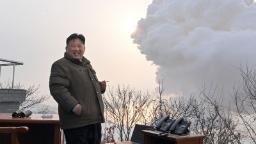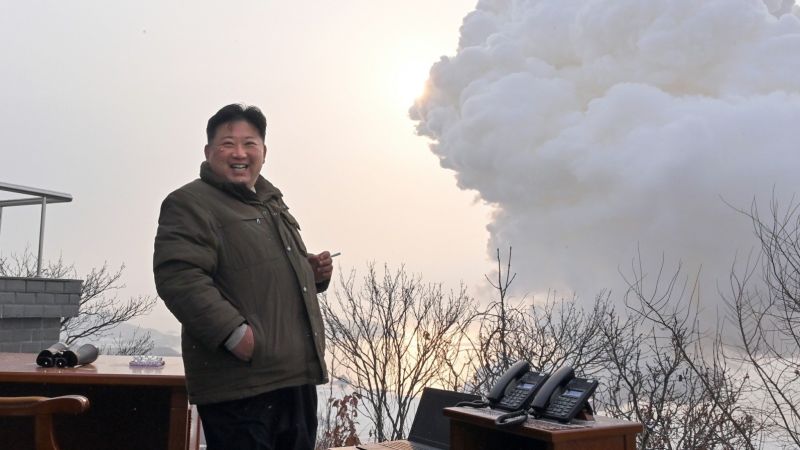North Korea claims successful rocket test that could bolster its ICBM force | CNN

Seoul, South Korea
CNN
—
North Korea on Friday said it has successfully tested a solid-fueled rocket motor, a development that could lead to Kim Jong Un’s regime being able to more quickly and reliably fire an intercontinental ballistic missile (ICBM) in the future.
The new high-thrust rocket motor was tested at a satellite launching ground site northwest of Pyongyang on Thursday, according to a report by the state-run Korean Central News Agency (KCNA).
Photos released by state media showed North Korean leader Kim attending the test, which KCNA said provided a “guarantee for the development of another new-type strategic weapon system.”
That could be a new ICBM, experts said.
“That, my friends, is the first stage of a solid propellant ICBM,” said Jeffrey Lewis, director of the East Asia Nonproliferation Program at the Center for Non-proliferation Studies, in a Twitter post.
Experts said the development could be significant if the new rocket engine could be successfully integrated with an ICBM.
“If North Korea’s high-thrust solid-fuel motor ground test at Sohae is nearly as successful as they claim, it is a significant step for the country’s nuclear-capable missile development,” said Leif-Eric Easley, a professor at Ewha University in Seoul.
Solid-fueled rockets are more stable than the liquid-fueled ones that North Korea has previously tested on ICBM launches. That means a solid-fueled ICBM could be moved more easily and launched quicker than a liquid-fueled one.
Because of those factors, the time for any adversary to react to a North Korean ICBM would be reduced.
“Once deployed, the technology would make North Korea’s nuclear forces more versatile, survivable, and dangerous,” Easley said.
Solid-fueled ICBMs are the state-of-the-art world standard. The United States’ main ICBM, the Minuteman III, is powered by three solid-fueled rocket motors.
Experts cautioned that despite the test, North Korea would still face many challenges to deploy such a solid-fueled ICBM.
“Getting from a solid-fuel motor ground test to operational, accurate, and reliable missiles involves many technical hurdles. North Korean media may exaggerate the country’s weapons capabilities and deployment timelines,” Easley said.
North Korea has been testing its ballistic missiles at a record pace, launching the projectiles on 34 occasions so far this year and sometimes testing multiple missiles each time, according to a CNN count.
On November 18, Pyongyang tested what KCNA said was a Hwasong-17, a liquid-fueled ICBM that would have the range to reach all of the continental US.
After guiding that launch, Kim said North Korea should “clearly demonstrate their strongest will to retaliate against the hysteric aggression war drills by the enemies seeking to destroy peace and stability in the Korean Peninsula and the region,” referring to the US and South Korea.
He also warned that North Korea will take a “more offensive” counteraction if the US “make a military bluffing in the Korean Peninsula and its surrounding area,” according to KCNA.
A senior US administration official described the Hwasong-17 as “further escalation,” because of its long-range and capability of reaching the US mainland.
Despite North Korea’s successful testing of long-range missiles, experts note that it has not shown whether it is capable of building a system that would allow a nuclear warhead to survive reentry into the Earth’s atmosphere.
Because ICBMs are shot into space, like space shuttles or space capsules, the warhead must be able to withstand the fiery journey through the outer layers of Earth’s atmosphere without burning up.
“I’m someone who thinks that they probably would (survive reentry). There are some people who are somewhat doubtful about that,” Lewis told CNN earlier this year.
Still, few question that North Korea is making progress.
“The tests are important. The North Koreans continue to qualitatively refine their nuclear capabilities in the pursuit of more robust nuclear deterrence of the United States,” said Ankit Panda, a Stanton senior fellow in the nuclear policy program at the Carnegie Endowment for International Peace.
“The bigger picture is that North Korea’s literally turning into a prominent operator of large-scale missile forces,” he said.
Meanwhile, US and international observers have been warning for months that North Korea appears to be preparing for an underground nuclear test, with satellite imagery showing activity at the nuclear test site. Such a test would be the hermit nation’s first in more than five years.
For all the latest world News Click Here

